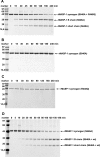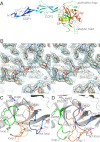Quantitative characterization of the activation steps of mannan-binding lectin (MBL)-associated serine proteases (MASPs) points to the central role of MASP-1 in the initiation of the complement lectin pathway
- PMID: 23386610
- PMCID: PMC3610966
- DOI: 10.1074/jbc.M112.446500
Quantitative characterization of the activation steps of mannan-binding lectin (MBL)-associated serine proteases (MASPs) points to the central role of MASP-1 in the initiation of the complement lectin pathway
Abstract
Mannan-binding lectin (MBL)-associated serine proteases, MASP-1 and MASP-2, have been thought to autoactivate when MBL/ficolin·MASP complexes bind to pathogens triggering the complement lectin pathway. Autoactivation of MASPs occurs in two steps: 1) zymogen autoactivation, when one proenzyme cleaves another proenzyme molecule of the same protease, and 2) autocatalytic activation, when the activated protease cleaves its own zymogen. Using recombinant catalytic fragments, we demonstrated that a stable proenzyme MASP-1 variant (R448Q) cleaved the inactive, catalytic site Ser-to-Ala variant (S646A). The autoactivation steps of MASP-1 were separately quantified using these mutants and the wild type enzyme. Analogous mutants were made for MASP-2, and rate constants of the autoactivation steps as well as the possible cross-activation steps between MASP-1 and MASP-2 were determined. Based on the rate constants, a kinetic model of lectin pathway activation was outlined. The zymogen autoactivation rate of MASP-1 is ∼3000-fold higher, and the autocatalytic activation of MASP-1 is about 140-fold faster than those of MASP-2. Moreover, both activated and proenzyme MASP-1 can effectively cleave proenzyme MASP-2. MASP-3, which does not autoactivate, is also cleaved by MASP-1 quite efficiently. The structure of the catalytic region of proenzyme MASP-1 R448Q was solved at 2.5 Å. Proenzyme MASP-1 R448Q readily cleaves synthetic substrates, and it is inhibited by a specific canonical inhibitor developed against active MASP-1, indicating that zymogen MASP-1 fluctuates between an inactive and an active-like conformation. The determined structure provides a feasible explanation for this phenomenon. In summary, autoactivation of MASP-1 is crucial for the activation of MBL/ficolin·MASP complexes, and in the proenzymic phase zymogen MASP-1 controls the process.
Figures







References
-
- Neuenschwander P. F., Fiore M. M., Morrissey J. H. (1993) Factor VII autoactivation proceeds via interaction of distinct protease-cofactor and zymogen-cofactor complexes. Implications of a two-dimensional enzyme kinetic mechanism. J. Biol. Chem. 268, 21489–21492 - PubMed
-
- Zhuo R., Siedlecki C. A., Vogler E. A. (2006) Autoactivation of blood factor XII at hydrophilic and hydrophobic surfaces. Biomaterials 27, 4325–4332 - PubMed
-
- Kardos J., Harmat V., Palló A., Barabás O., Szilágyi K., Gráf L., Náray-Szabó G., Goto Y., Závodszky P., Gál P. (2008) Revisiting the mechanism of the autoactivation of the complement protease C1r in the C1 complex. Structure of the active catalytic region of C1r. Mol. Immunol. 45, 1752–1760 - PubMed
-
- Gál P., Barna L., Kocsis A., Závodszky P. (2007) Serine proteases of the classical and lectin pathways. Similarities and differences. Immunobiology 212, 267–277 - PubMed
Publication types
MeSH terms
Substances
LinkOut - more resources
Full Text Sources
Other Literature Sources
Miscellaneous

